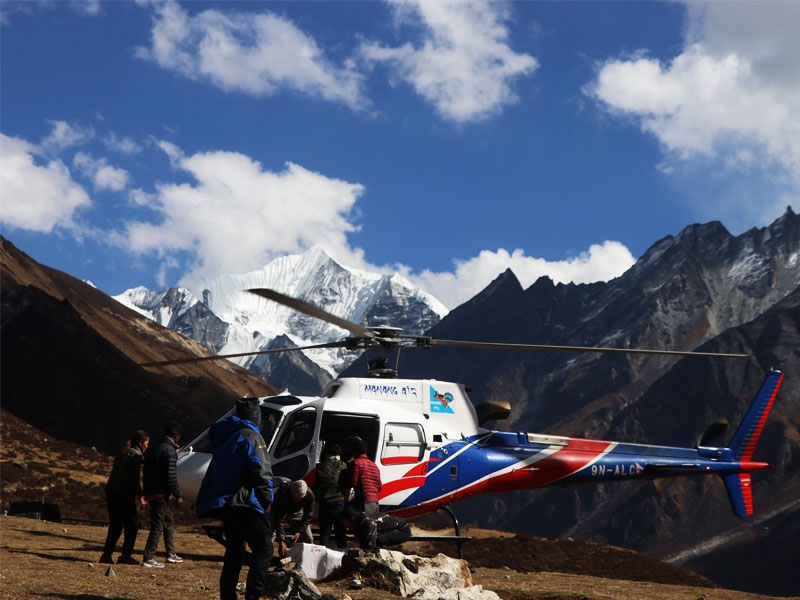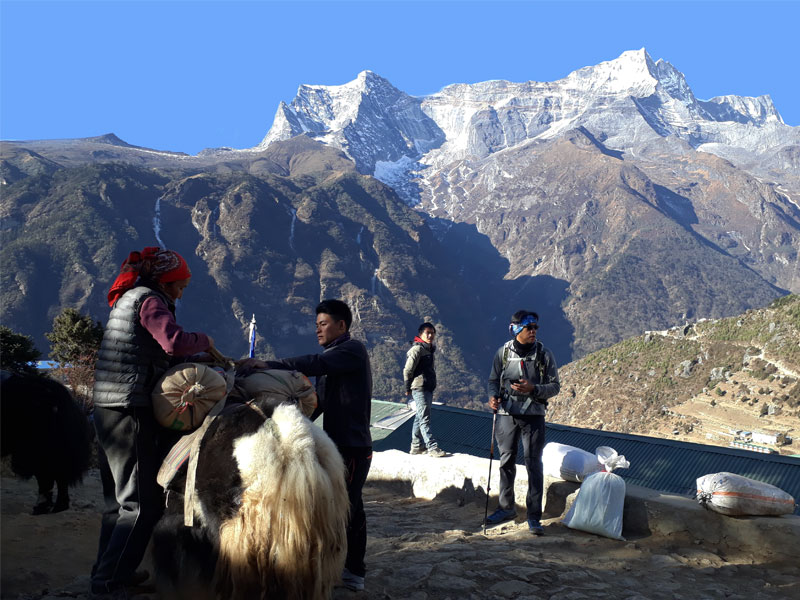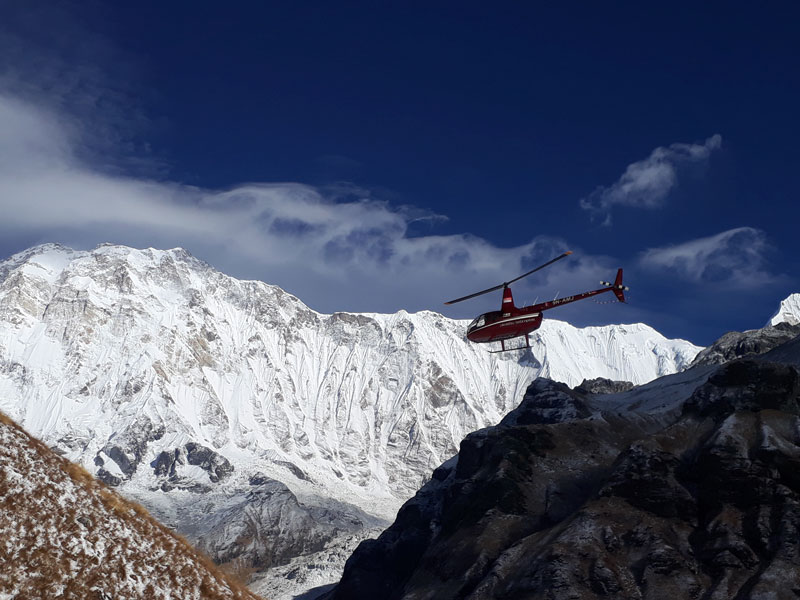Introduction
We want trekkers to know about the common risk factors while trekking into the Himalayas when the point comes about altitude. Normally, till 3300M/10827Ft we don’t see the hazardous conditions of trekkers but as we ascend further, you might encounter some symptoms of moderate level, and some symptoms of altitude sickness might occur from the altitude of 2400 m/7874ft, this mainly might happen to trekkers who are native from the sea level.
Some symptoms might happen to almost all trekkers no matter at what altitude one has been before. Among them, physically fit trekkers' health gets better while some suffer from the environment of the Himalayas and have no choice but to descend to a lower altitude.
Let’s see what altitude sickness is, its type, and the cause of altitude sickness we will advise some precautions to cope with when you or your friends suffer from such altitude sickness.
What is Altitude Sickness
Let’s start with altitude sickness and its type. Altitude sickness is mainly related to travelers when they head toward high altitudes. Altitude sickness is also known as ‘Mountain Sickness’ or ‘High Altitude Sickness’.

What-so-ever, the name may be called, it is a group of symptoms that strike travelers while hiking or climbing to a higher altitude when your body cannot acclimatize to the environment of such a high altitude.
This is mainly due to quick ascend when your body does not get time to cope with the air pressure at such a high altitude.
Types of Altitude Sickness
Acute Mountain Sickness (AMS): Acute Mountain Sickness is a temperate form of altitude sickness and is very common as well. AMS affects trekkers, hikers, and climbers while heading to a high altitude in a short period. This is caused by to reduction in air pressure and oxygen level at high altitudes.
The common symptoms of Acute Mountain Sickness are Dizziness, Headache, muscle aches, nausea, and some sort of hangover.
High Altitude Pulmonary Edema (HAPE): High Altitude Pulmonary Edema is a severe and life-threatening form of altitude sickness. This might result in the fatal accident of trekkers if taken lightly.
HAPE mainly occurs as a result of AMS, when travelers avoid the call of their body at the very first level and are ascending at an unconditional pace without allowing their body to acclimatize to the air pressure of the high altitude.
HAPE is a serious form of altitude sickness when the trekker's lungs build up with fluid, resulting in lung damage. This can be very dangerous and life-threatening and requires medical attention without delay.
High Altitude Cerebral Edema (HACE): High Altitude Cerebral Edema is the last and most life-threatening condition of altitude sickness. This is a stage where travelers might lose consciousness level due to the rise of fluid in the brain. This will be hazardous to your life if you don’t seek a medical emergency without delay.
Symptoms Of Altitude Sickness
What are the possible symptoms of Altitude Sickness?
Some of the high possible symptoms of high-altitude sickness include:
- Loss of appetite
- Problem with sleep
- Headache
- Dizziness
- Vomiting
- Nausea
- Fatigue
- Loss of energy
- Shortness of breath
- Confusion
- Inability to walk
- cough
What Leads to Altitude Sickness?
The main reason for altitude sickness is the pressure of air and the level of oxygen at a higher altitude. The pressure of air that surrounds us and our surrounding environment is called barometric pressure.
As we ascend to a higher altitude this pressure drops down with the temperature rise, as the pressure drops down the level of oxygen decreases with the rise of altitude.
It does not mean all will have the problem of altitude sickness, it mainly depends upon our previous experience of being at such altitude and also the altitude we belong to.
Mainly if you belong to the altitude of sea level, there is the most possibility of being entangled with altitude sickness but also depends upon how high in terms of altitude you travel.
Meanwhile, if you live in a place that is moderately high in terms of altitude from the sea leave. Your body gets used to the air pressure, but you need to think while traveling to a higher altitude compared to the altitude you have been to before.
For this, your body needs time to adjust to the change in air pressure. This ‘time’, plays a vital role in coping with the oxygen while hiking to a high altitude.
So, ‘slow and steady always wins the race’ is very applicable while hiking to high altitudes. Give a sufficient amount of time to your internal organs to cope with the air pressure and oxygen of the high altitude.
Prevention From Altitude Sickness

Prevention is always better than cure, how to prevent yourself from altitude sickness might be your question and it is to all while hiking to the higher altitude. The best way to get rid of any sort of mountain sickness related to high altitude is to manage the time and pace of your hike.
This also includes acclimatization to make your lungs and brain get a sufficient amount of oxygen and avoid alcoholic drinks and the use of tobacco (smoking).
Now, how does it work, mainly while hiking you need to know about the altitude of your camp. Trekkers should be concerned with the fact that it is safe and better to ascend 300-500 meters per day when you are already at an altitude of 3300 meters.
Next will be to maintain the physical condition of your body. This means when you are planning to trek to a higher altitude make sure you start some physical exercise before your trip.
This includes swimming, jogging, a short hike, some indoor games or sports, etc. will help you for a long and high hike to control the speed of breathing and help your stamina.
And last but not least, it is always recommended to hike higher and sleep lower. This means when you are at your camp after a break try to unload yourself with all your belongings but carry a bottle of water and try to hike at a nominal pace to some hills around which are higher than the camp you are supposed to stay overnight. This will help your body to cope with the air pressure of the high altitude.
Apart from all these tips, while hiking control your pace try to take some rest, and drink a sufficient amount of water. Make sure you are not forcing your body to hike more than it dares to do.
Treatment Of Altitude Sickness

Never think of using medication in case of hiking at a higher altitude, if you mentally go for medication in case of altitude sickness you will not be able to maintain your pace and manage your time.
So, better try to acclimatize yourself and cove lesser altitude, this will be the best way to avoid altitude sickness.
Now, the question arises of what to do when you are with the symptoms of altitude sickness. The best way to deal with when you recognize symptoms related to altitude sickness is to descend and try to have garlic or ginger soup, this will be available at all the tea houses while traveling in the Himalayas of Nepal.
Talk with your guide, friends, or the hotel owners about your condition, if you try to avoid the symptoms there will be a high possibility of the second and third stages of altitude sickness, which is High Altitude Pulmonary Edema (HAPE) and High Altitude Cerebral Edema (HACE) which are serious and life-threatening and must need emergency medical attention and when you are single hikers into the Himalayas without friends or guide, this will be difficult.
But if you are mentally planning to use medication, use it before the trek starts or plan from what altitude you would prefer to use, as it takes a couple of hours for the medication to work on your body to increase the oxygen level.
Now, what are the possible medicines you can use for altitude sickness that can never be fixed? Please consult with your doctor before the trip and let him/her know about the altitude you are planning to head.
Some of the medicines which is used for altitude sickness are Diamox, for altitude headache Ibuprofen, Dexamethasone, Nifedipine, etc. which must be used upon the doctor’s suggestion. So, consult before you use them.
So, try to figure out the symptoms at the very beginning and descend lower to take some rest or to acclimatize yourself, and the next day when your condition becomes normal you can ascend further to the same place.
For more information WhatsApp: +977-9841161593 or Email: [email protected]





